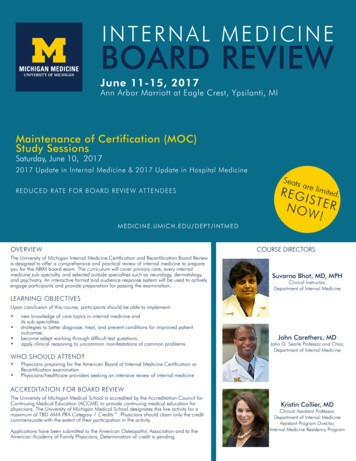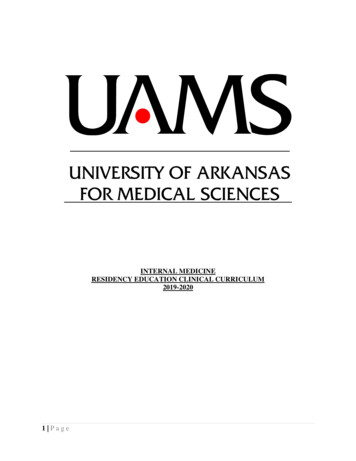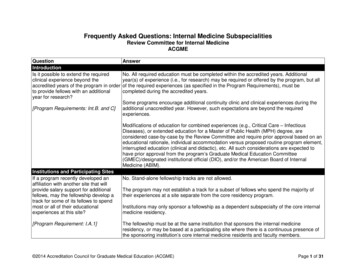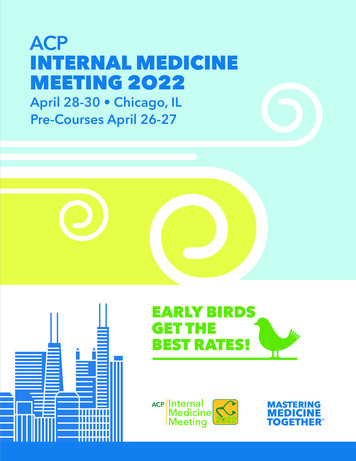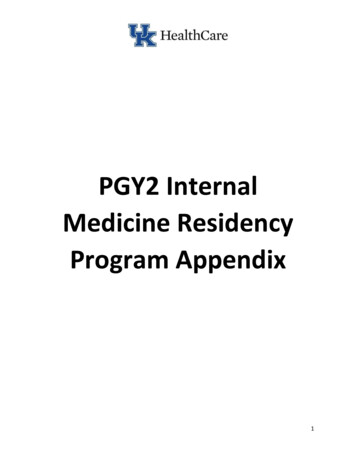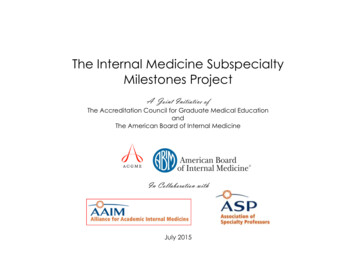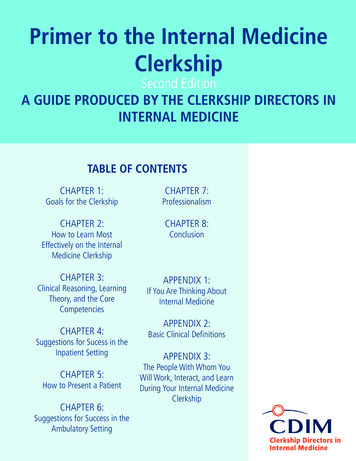
Transcription
Primer to the Internal MedicineClerkshipSecond EditionA GUIDE PRODUCED BY THE CLERKSHIP DIRECTORS ININTERNAL MEDICINETABLE OF CONTENTSCHAPTER 1:CHAPTER 7:Goals for the ClerkshipProfessionalismCHAPTER 2:CHAPTER 8:How to Learn MostEffectively on the InternalMedicine ClerkshipConclusionCHAPTER 3:APPENDIX 1:Clinical Reasoning, LearningTheory, and the CoreCompetenciesCHAPTER 4:Suggestions for Sucess in theInpatient SettingCHAPTER 5:How to Present a PatientCHAPTER 6:Suggestions for Success in theAmbulatory SettingIf You Are Thinking AboutInternal MedicineAPPENDIX 2:Basic Clinical DefinitionsAPPENDIX 3:The People With Whom YouWill Work, Interact, and LearnDuring Your Internal MedicineClerkship
Primer to the Internal MedicineClerkshipSecond EditionA GUIDE PRODUCED BY THE CLERKSHIP DIRECTORS ININTERNAL MEDICINEEDITOR AND CO-AUTHOR:Michael Picchioni, MDBaystate Medical CenterTufts University School of MedicineCO-AUTHORS:Anna Headly, MDUniversity of Medicine and Dentistryof New Jersey-Robert Wood JohnsonMedical SchoolPatrick NicholsUniversity of North Texas HealthScience CenterSuma Pokala, MDAndrew R. Hoellein, MDUniversity of Kentucky College ofMedicineTexas A&M University College ofMedicineJames L. Sebastian, MDLucy GoddardMedical College of WisconsinCynthia H. Ledford, MDUniversity of Iowa Carver College ofMedicineYale University School of MedicineOhio State University College ofMedicineHeather Strah
TOP 10 WAYS TO EXCEL ON THE INTERNAL MEDICINECLERKSHIP1.Find out what your residents and preceptors expect of you. Meet and try toexceed their expectations. Follow through on every assigned task.2.Be actively involved in the care of your patients to the greatest extentpossible. Go the extra mile for your patients. You will benefit as much asthey will.3.Go the extra mile for your team. Additional learning will follow. The moreyou put in, the more you will gain.4.Read consistently and deeply about the problems your patients face. Raisewhat you learn in your discussions with your team and in your notes.Educate your team members about what you learn whenever possible.5.Learn to do excellent presentations as early as possible. This will make youmore effective in patient care and gain the confidence of your supervisors toallow you more involvement in patient care.6.Ask good questions.7.Speak up—share your thoughts in teaching sessions, share your opinionsabout your patients’ care, constructively discuss how to improve theeducation you are receiving and the systems around you.8.Actively seek feedback and reflect on your experiences.9.Keep your goals focused on the right priorities, in the following order:patient care, learning, and personal satisfaction. You should always strive tomeet all three goals.10. Always be enthusiastic. Be caring and conscientious and strive to deliveroutstanding quality to your patients as you learn as much as you can fromevery experience.
INTRODUCTIONWelcome to your internal medicine clerkship. We are genuinely delighted that you have joinedus for this short period. During the clerkship, you will likely get only a small glimpse into theworld of internal medicine. Nevertheless, through this experience, we expect that you willacquire fundamental skills, reinforce and expand your knowledge, and develop personally andprofessionally. We hope that this experience inspires you to learn and experience more of whatinternal medicine has to offer. Regardless of your future career path, we wish you the mostexciting, stimulating, rewarding, and transforming experience possible over the coming weeks.The information in this booklet has been produced through the collaboration and consensus ofinternal medicine clerkship directors across the country, most of whom have spent many yearsteaching, evaluating, and advising students. Additionally, a substantial component of this bookhas come from the insights of students who recently completed their clerkship. We try toprovide the most generic, reliable, “tried and true” approaches to the clerkship. We hope thatthis guide will provide you with knowledge and perspective that will last well beyond yourinternal medicine clerkship.It is important to note that information provided by your clerkship director should takeprecedence over these suggestions.ACKNOWLEDGMENTThe purpose of this second edition is more to update than improve upon the initial primer. Theoriginal version was such an important addition to the tools available to help enhance the internalmedicine clerkship that we were quite inspired and left much of it unchanged. The current editorand co-authors are deeply indebted to the original group of authors and, of course, Eric J. Alper,MD, the editor and mastermind behind the first edition, for providing us this wonderful template.Disclaimer – Any reference to a product in this book does not imply any endorsement of theproduct by CDIM or the editor and authors. Product references are only included to provideexamples of resources and are not meant to be exhaustive lists of available material.
CHAPTER 1: GOALS FOR THE CLERKSHIPThe primary focus of the internal medicine clerkship is to increase your capacity to function as acaring, increasingly independent, but supervised clinician on an interdisciplinary internalmedicine team.For the specific goals of your internal medicine clerkship, consult the material your clerkshipdirector provides. Many clerkship directors use the national CDIM-SGIM Core MedicineClerkship Curriculum. You can access this guide atwww.im.org/CDIM/CurriculumGuide/default.htm. In general, the internal medicine clerkship isyour main opportunity to become familiar with the common acute and chronic illnesses adultpatients face as well as screening and preventive medicine. While expanding your medicalknowledge, you will also be solidifying basic clinical skills such as patient interviewing, physicalexamination, and communication through case presentations and written documentation. Thistime is also a major opportunity to improve more advanced skills such as clinical reasoning anddeveloping physician-patient relationships.In seeking to achieve the goals of the clerkship, we believe it is important for you to understandwhat internal medicine is and what qualities characterize the ideal internist. In the broadestsense, internal medicine is medicine for adults. By far the largest medical specialty, internalmedicine constitutes a major part of the overall landscape of medicine. Internists care for abroad spectrum of patients, ranging in age from adolescents to the ever-growing elderlypopulation. Practitioners of internal medicine include both general internists and subspecialists.General internists coordinate and provide longitudinal care for adults with any problem. Internalmedicine also includes subspecialists, such as cardiologists, nephrologists, oncologists, criticalcare physicians, and many others, who focus on the care of patients with specific diseases anddisorders, (Appendix 1 is a more detailed description of the variety of careers available ininternal medicine.) Many of the subspecialties of internal medicine are heavily procedure-based.An internist’s practice may be mostly office-based, mostly hospital-based, or a combination ofboth. The general internist coordinates the care of the whole patient by working in concert withcolleagues. Subspecialists may accept this role for patients whose major problems are withintheir focus or serve primarily as consultants to generalists and specialists in other disciplines.The internist is a clinical problem-solver, able to integrate pathophysiological, psychosocial,epidemiological, and “bedside” information to address urgent problems, manage chronic illness,and promote health. Internists apply the best scientific evidence to patient care and manyparticipate in research. Frequently, internists teach medical students and residents.“An internist is a physician who can embrace complexity yet act with simplicity.”— Louis Pangaro, MD, Vice Chair for Educational Programs, Department ofMedicine, Uniformed Services University of the Health Sciences.BASIC PROFESSIONAL EXPECTATIONS OF THIRD-YEAR CLERKSHIP STUDENTSIt is our hope that the clerkship provides you with exposure to the breadth of possibilitiesavailable in internal medicine, and that this primer provides you with the tools to make the most
of that experience. Your clerkship director will provide a more specific guide to the duties andexpectations of the site where you will be performing your rotation. The following expectationsare common to all sites: Attend all clerkship activities on time. If you must be absent, get permission in advance. Dress professionally. The way you dress makes a statement about your school, hospital,and the medical profession; it will influence the way you are perceived by your patientsand your colleagues. If you have any question about what constitutes professional dress,consult your clerkship director. Treat every member of the health care team, your colleagues on the clerkship team, andevery patient with respect. Always introduce yourself, correctly identifying your role on the team as a medicalstudent. “Student doctor” is a particularly useful description. Answer your pager and email in a reasonable time frame. Make sure your handwriting is legible and ensure every note includes your name, role,and pager number. Preserve confidentiality do not discuss patients in public places and destroy all paperswith patient-specific information that are not part of the medical record. Do not look inthe chart (paper or electronic) of any patient for whom you are not caring.
CHAPTER 2: HOW TO LEARN MOST EFFECTIVELY ON THE INTERNALMEDICINE CLERKSHIPMost learning will take place outside of the classroom through experiences with patients andinteractions with your team. While you may be offered a series of lectures, the bulk of yourlearning should be self-directed. It is essential that you read regularly to answer the questionsencountered each day. Take responsibility for your own education. Make sure that throughreading, experiences, and didactics, you meet the goals of the clerkship. Understand and clarify, if necessary, the expectations your residents, attendingphysicians, and course directors have of you. Keep a list of questions that arise during your day and seek the answers. Demonstrate that you are a self-directed learner by reading during the clerkship. Youreducation will depend on it. Supplement reading about your patients with periodic use of a review book with testquestions to ensure you cover core topics and are prepared for examinations of yourknowledge. Be an active participant in your patients’ care. Be the “go-to” person for all of yourpatients. Each problem or question that arises is an opportunity to learn. Be a team player. Be available to help all other team members, including other students. Be around―do not expect your team to find you when something important is happening.Although you may not always recognize it, you are an integral member of the team. Donot underestimate your importance. Knowing where you fit in and fulfilling the part isvery important. As a junior member of the team, it is generally best to be malleable and“go with the flow.” However, if you have an important question or concern, it is equallyimportant that you ask the question or express the concern. Try to be observed and solicit feedback on a regular basis, both positive and negative.Constructive feedback is essential to your growth. Read about all of your patients in depth. Learning moments may come when you leastexpect them. Pay attention at all times, even when the focus is not on you or yourpatient. You can learn as much and sometimes more from the patients of others. Strive to practice evidence-based medicine. It is our responsibility to bring the bestscientific evidence to every clinical decision that is made. Use evidence-based clinicalpractice guidelines and standard order sets whenever possible and learn from them.
Try to acquire all of the best lessons from your teachers. Much as they strive forperfection in every behavior and decision, your role models may not always be able tomanage every situation in the best manner every time. Try to model their best skills andbehaviors, while learning from their mistakes as well as your own.It is important to gain broad knowledge about the spectrum of medical illnesses as it will beimpossible for you to see patients with all conditions about which you need to learn during yourclerkship. Follow a structured reading program. It is helpful to have an overview or concisetextbook of medicine, which you can read from cover to cover, during the course of the clerkshipsuch as the ACP-CDIM Internal Medicine Essentials for Clerkship Students, Cecil Essentials ofMedicine, Paauw’s Internal Medicine Clerkship Guide, and the First Exposure to InternalMedicine books among others. A reference textbook of medicine, such as Harrison’s Principlesof Internal Medicine, Cecil Textbook of Medicine, or ACP Medicine, is recommended for mostpatient-related reading. Information about reading resources is available online at the AAIMmay (www.im.org) and ACP (www.acponline.org) websites. Your clerkship director canprovide specific recommendations about which books and resources are preferred locally.Students also need additional resources to read in greater depth; review articles from theliterature or electronic resources are good resources to access. You may want access to pocketmanuals for rapid reference (on bedside rounds or in the emergency department, for example).The Washington Manual of Medical Therapeutics is invaluable for formulating treatment plansand writing orders. Ferri’s Care of the Medical Patient and The 5-Minute Clinical Consult arealso commonly used. These abbreviated resources can be purchased for electronic devices forslightly more than their print counterparts (www.skyscape.com has many titles). When it comestime to prepare for the clerkship final examination, many students use MKSAP for Students, anexcellent resource produced by CDIM and ACP that contains questions with detailedexplanations organized around the core CDIM training problems.ACP’s Physician Information and Education Resource (PIER) is an electronic resource thatprovides evidence-based guidance for managing clinical problems. Access to PIER is free forACP members; membership is free for students. UpToDate is another excellent electronicresource for investigating specific clinical questions. However, these resources will be lessvaluable for overview reading of larger clinical topics (an overview of congestive heart failure,for instance). Additionally, the Internet provides access to an enormous library of medicalinformation as a rapid reference. It is always a good idea to start at your school’s librarywebsite.Students should be self-directed learners and share what they have learned with their colleagues.This practice of continuous, ongoing learning will be necessary throughout your career. Whenyou read, consider preparing a one-page summary; be prepared to present this synopsis to yourteam. If your attending or resident does not assign you a topic, pick a clinical subject thatinterests you and is relevant to at least one of the patients on your current team. If you arehaving trouble choosing a topic, ask for help from your attending or resident. If you have beengiven a specific topic to research, do not be afraid to ask for guidance. A concise, summativehandout that you share with your team is a nice touch.
CHAPTER 3: CLINICAL REASONING, LEARNING THEORY, AND THECORE COMPETENCIESFORMULATING A DIFFERENTIAL DIAGNOSISThe internal medicine clerkship is the primary rotation in which students learn and develop thecomplex cognitive skill of accurately assessing clinical situations and arriving at a diagnosis. Tobecome a master diagnostician, you need knowledge, an ability to gather accurate clinical datafrom the patient, superb problem-solving skills, and the resourcefulness to pursue self-directedlearning. Memorizing lists of diagnoses that might explain a particular sign, symptom, orlaboratory/diagnostic test abnormality is insufficient. A differential of diagnoses must becarefully tailored to the specific patient’s clinical situation. This skill requires an ability toidentify problems, translate abnormalities into precise medical terminology, prioritize issues, anddistill the key features of the clinical presentation. The patient’s presentation is matched againstpatterns of disease presentation to identify what diagnoses are most likely, less likely, andunlikely.Three basic strategies exist for problem solving: hypothetico-deductive reasoning (also calledbackward thinking), algorithmic thinking (also known as forward thinking), and patternrecognition. Expert diagnosticians tend to use pattern recognition and algorithmic thinking, butreturn to hypothetico-deductive reasoning if the first two strategies are unsuccessful. Noviceclinical reasoners tend to use hypothetico-deductive reasoning more often than the otherstrategies.Hypothetico-Deductive ReasoningIn hypothetico-deductive reasoning, a differential list is based often on a single symptom or sign,such as the chief complaint. Each diagnosis in the list is then tested “back” to the patient’ssituation until the correct diagnosis is found (hence the nickname “backward thinking”). With asufficiently complete list of diagnoses (i.e., the diagnosis is on the list!) and with time andpersistence, this strategy works well. The drawbacks to backward thinking are its inefficiencyand that it treats all diagnoses on the list as equally plausible. Use of a list-generating strategy ora mnemonic device can be an effective tool to help beginning clinicians identify potentialdiagnoses. When using backward thinking, the key to finding the correct diagnosis is to ensure iton the list: therefore, the longer the list, the better.These common scaffolds are used to help generate lists of differentials:1. Anatomic Approach. The list is based on what anatomic structures are in the vicinityof the patient’s complaint. This method works particularly well for localized pain.
2. Systems Approach (also known as Universal Differential Diagnosis).Lists are generated based on pathophysiology or underlying mechanisms of diseaseprocesses. The categories/systems ionalPsychiatricToxicTrauma/MechanicalVascularWhen using a mnemonic device to recall common lists in medicine, remember such listsare not taryAutoimmuneToxic/metabolicEndocrine3. Other sources of lists.With electronic access to information, it is easy to find sources of lists such as The 5Minute Clinical Consult, Ferri’s Instant Diagnosis, and UpToDate.
Forward ThinkingForward thinking refers to a problem-solving strategy that progressively adds more detail aboutthe clinical problem to narrow the differential of diagnoses. It can often be illustrated as analgorithm.Example: HyponatremiaHyponatremia(Low Na)Hypovolemic(Deficit of Total Body Water (TBW)and larger Na deficit)Euvolemic(Mild excess TBW)Hypervolemic(Excess Na and TBW)Urine Na 20 mEq/LUrine Na 10mEq/LUrine Na 20mEq/LUrine Na 10mEq/LRenal LossRTASalt enalLossGI fluid lossThird NephroticsyndromeCHFCirrhosisUrine Na 20mEq/LRenal failureThe differential is based on adding characteristics of the syndrome to narrow the list of potentialdiagnoses, e.g., hyponatremia (as above), anemia (macrocytic, normocytic, or microcytic?) orgastrointestinal bleeding (upper or lower?). There are many common algorithms in clinicalmedicine. Experienced physicians group related diagnoses to develop their own algorithms thatuse branching logic to help solve clinical problems. Expert diagnosticians use branch points toguide clarifying questions while obtaining the history. Look for different forward thinkingalgorithms in basic medical textbooks and pocket manuals for the wards.Pattern RecognitionPhysicians often instantaneously recognize the patterns of diseases with which their patientspresent. Pattern recognition is a common strategy used in everyday life. When a nephewrecognizes his great-aunt, it is instantaneous. He thinks, “Great Aunt Minnie!” He did not try aforward thinking approach” “Here is a little old lady with blue hair, orthopedic shoes, and anoutrageous orange handbag. I know who this must be, my Great Aunt Minnie!” He did notconsider hypothesis testing: “This is a little old lady. Could it be the Queen of England? Couldit be my grandmother?” When pattern recognition is used in medicine, the trigger for the
diagnosis is the disease, not the syndrome and not the symptom. The physician arrives at thediagnosis by instantaneously processing and synthesizing the patient’s clinical information torecognize that the patient’s presentation exactly matches the disease’s illness script. To use thismethod of reasoning, the physician must have clinical experience; have an excellent knowledgebase of classic disease illness scripts; be adept at processing, prioritizing, and synthesizingclinical information into the patient’s illness script; and use a compare and contrast mentality.Until a physician has a great deal of clinical experience, diagnostic errors can be made if patternrecognition is attempted prematurely. With this method, knowledge has become organized intocomplex networks, in which the multiple branching algorithms are interlinked.PUTTING IT ALL TOGETHERStudents more efficiently arrive at an accurate differential and develop the knowledgeorganization to support more advanced problem-solving skills when they use a systematicapproach to managing clinical information. The most common approach is to develop a problemlist, synthesize a one-sentence summary, and then create a differential of potential diagnoses.The assessment and differential guides the plan to diagnose and treat the patient. While thisapproach is used by nearly all physicians, it is not necessarily communicated explicitly tostudents who are learning these skills. The following is a stepwise approach to solving clinicalproblems from problem list to a synthesized summary of the patient’s presentation.The Problem List Identify all problems or key features from the history and examination. Process the list into accurate and precise medical terminologyo Process descriptively, e.g. dizziness like “spinning” becomes the more precise“vertigo.”o Process summatively, e.g. features such as chest pain, hypotension, S3 gallop,pulmonary edema, and poor perfusion combine to become “chest pain withcardiogenic shock.” Reduce the listo Remove redundancies.o Eliminate “due to,” e.g. eliminate the “dyspnea” due to the more specific problemof “pleural effusion.”o Drop nonspecific abnormalities, e.g. “malaise” in the patient with pneumonia. Prioritize the problems and identify how they relate, including key markers of severity orcomplications, e.g. mitral regurgitation complicating acute coronary syndrome. Identify which problems are unrelated to the primary presenting syndrome and separatethese as problems of secondary importance.The One-Sentence Summary (Synthesis of Patient’s Presentation)Every attending physician will ask a student to give a short summary of the case either after afull presentation or in place of one. The student must interpret and synthesize many data pointsto arrive at this summary. The best one-sentence summary of a patient’s clinical situationconcisely highlights the most pertinent features without omitting any significant points. Thesentence should contain the following three key components: the patient’s epidemiology, the
temporal pattern, and a syndrome statement. When using this format, the summary models anillness script, the basic construct that physicians use to recall and recognize a disease. Theclassic disease illness script emphasizes (1) who gets it, (2) how does it present with respect totime, and (3) what key features are expected at presentation.Example: Summary of the Patient’s Presentation: Epidemiology: Who is this patient?o Include only the patient demographics, past medical history, and social and familyhistory that make him/her at risk for diseases that present in this manner.o Omit demographics, past medical history, and social and family history that areunrelated to the current clinical situation. Temporal pattern: How did the symptoms and signs presenting with respect to time?o Describe the chronology of the presentation: Is it acute or chronic? Constant orintermittent? Is it worsening or improving? Syndrome statement: What are the key clinical features of the presentation?o Construct this phrase by combining, prioritizing, and relating the identifiedproblems.Common student mistakes are to include too much and irrelevant patient epidemiology, forget orfail to emphasize the temporal pattern, or accidentally omit or incorrectly state important parts ofthe syndrome.Model summary statement: “Mrs. M. is an elderly woman with atrial fibrillation and heartfailure, who presents with sudden onset right hemiparesis and dysarthria.”The Differential DiagnosisA differential of diagnoses that commits to what is most likely and what is unlikely is developedby comparing the patient’s symptoms and findings to particular disease entities. To accuratelymatch the patient’s presentation to the known patterns of diseases, physicians store and retrieveknowledge about how diseases present. The basic construct that physicians use to recall andrecognize diseases in patients is the illness script.Classic Disease Illness Scripts: Epidemiology (who gets it) Temporal pattern (how it presents with respect to time) Syndrome statement (key clinical features present at the time of initial diagnosis)Other information about pathophysiology, therapies, late onset complications, and atypicalpresentations are anchored to uniform memory framework, while these three basic componentsremain at the core. How likely a disease is in a specific patient can be estimated by comparingthe classic disease illness scripts to the individual patient’s presentation. The better the fit, themore likely the diagnosis under consideration is present. Prioritize the differential based on fit.
o Very likely diagnoses fit the epidemiology, temporal pattern, and syndrome.o Less likely diagnoses fit some, but not all key features of the patient; or thepatient has only some of the key features of the disease.o Diagnoses relegated to ‘unlikely’ match only one or a few symptoms or findings.Also, consider how common the disease is.Always consider prevalence: a common disease is always more likely than a rare condition. Ingeneral, a patient is more likely to have a condition that is a common presentation of a commoncondition before an atypical presentation of a common disease or a typical presentation of a raredisease. An atypical presentation of a rare disease is much less likely. Internists love to considerrare diseases; after all, thinking of the disease is the first step to making the diagnosis. It is goodto recognize and consider a rare disease, but put the disease likelihood into perspective byremembering the overall prevalence of the disease.In general:Typicalpresentationof acommondisease Atypicalpresentationof acommondisease Typicalpresentationof araredisease Atypicalpresentationof ararediseasePhysicians use the prioritized differential to guide the plan for the patient. A physician will testand/or treat for diagnoses that are most likely before those diagnoses that are unlikely. The onlyexception to this rule is for diagnoses that are potential emergencies, i.e., those that might kill apatient if missed in the first 24 hours. Myocardial infarction, pulmonary embolus, bacterialmeningitis fit this definition. Therefore, physicians have a lowered threshold to test and treat forthese diseases.SUMMARYProblem List Æ (processing) Æ Summary of Æ (matching to diagnoses) Æ DifferentialPatient’s Presentation
CHAPTER 4: SUGGESTIONS FOR SUCCESS IN THE INPATIENT SETTINGYour job in the inpatient setting is to meticulously care for the panel of patients to which you areassigned, while at the same time, learning as much as you possibly can. At times, service andlearning may seem to be at odds but, generally speaking, they coexist quite well. It is useful torecognize that the faculty and house officers with whom you work are attempting to balancecompeting demands as well. Actively and enthusiastically participate in rounds. They are an opportunity for you todisplay your critical thinking skills and to demonstrate your understanding of the keyconcepts that underlie your patient’s medical problems. Demonstrate effective organizational skills. You will learn more, have more fun,contribute more to patient care, and be less stressed if you keep yourself, your schedule,and your patient information organized. It will come as no surprise to you that being aphysician is a very hectic business. Some tips to help start training yourself to beorganized include:o Carry a calendar and mark all conferences and call days right away.o Develop a system for keeping patient data and tasks at your fingertips (note cards,fill-in-the blank templates, PDA).o Have information about your patients immediately available (e.g., vital signs,laboratory data, diagnostic studies, medications).PERFORMING INPATIENT HISTORY AND PHYSICALSWhen new patients are assigned to your team, your initial responsibility will generally consist ofperforming a complete history and physical examination (H&P). The data you collect on yourpatient will likely be more detail
internal medicine clerkship directors across the country, most of whom have spent many years teaching, evaluating, and advising students. Additionally, a substantial component of this book . Supplement reading about your patients with periodic use of a review book with test questions to ensure you cover core topics and are prepared for .



